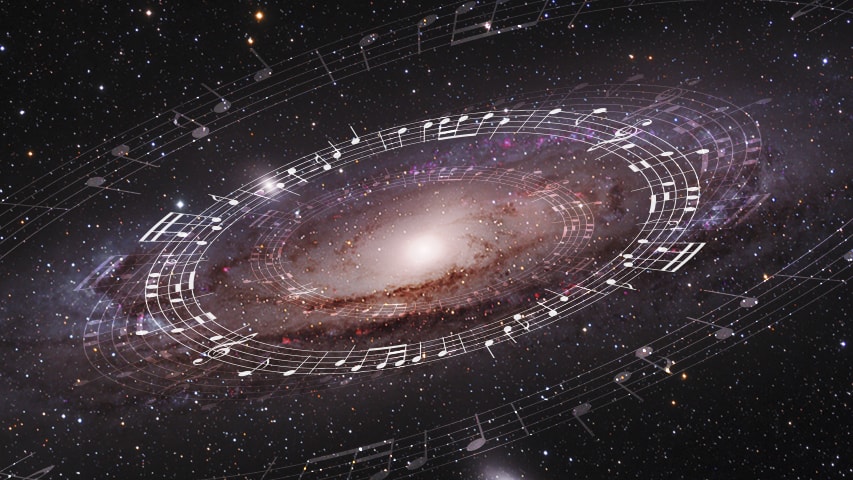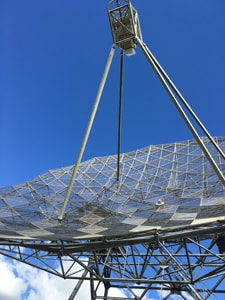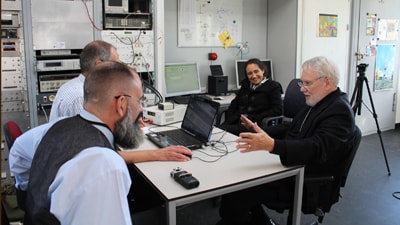Artists Send Symphony to the Stars
By Pam Wigley

Since the beginning of time, people around the world have looked up at the vast sky and wondered, "Is anybody out there?" Carnegie Mellon University Professor of Art and pioneering space artist Lowry Burgess thinks so, and he's banking on the fact that life forms in space appreciate the arts the same way humans do.
 The telescope at Dwingeloo Radio Observatory, The Netherlands, where the transmission took place Oct. 4.
The telescope at Dwingeloo Radio Observatory, The Netherlands, where the transmission took place Oct. 4.
To that end, Burgess and colleague Andrew Kaiser, a longtime space musician, composed "Symphony for Andromeda," a "10-year labor of love" that incorporates an extraordinary array of natural sounds and original music in five separate movements called canticles.
The symphony, sponsored by Dutch interdisciplinary artist Daniela de Paulis, was broadcast to the galaxy Andromeda on Oct. 4 from a large radio telescope at Dwingeloo Radio Observatory in the Netherlands. It is, Burgess said, the first time anything like this has been done.
The work is traveling in outer space toward the Andromeda galaxy 2.5 million light years from Earth. Andromeda is a twin to Earth's Milky Way Galaxy and the only visible galaxy in Earth's night sky.
Traveling at 1 billion miles per day, the symphony will travel in space for some time before reaching its destination. Along the way, Burgess predicts the composition will be heard by life forms that will appreciate the music as a complex communication meant to convey hope.
It was a labor of love centered on music and space that inspired Burgess and Kaiser to create the symphonic piece and plan its journey into outer space. Kaiser, once a fellow in the Frank-Ratchye STUDIO for Creative Inquiry at Carnegie Mellon, worked with Burgess to perfect the sound and imaging for the piece, which he ultimately crafted into a symphonic hologram.
Burgess calls the work "an infinitely moving broadcast" that is scheduled to travel to the moon in 2017 as part of the "MoonArk," a device that will be carried on the Astrobotic Lunar Lander. The lander, one of several crafts in competition for the Google Lunar X Prize, will be placed aboard a Space-X rocket and launched from the Kennedy Space Center in Cape Canaveral, Fla. The MoonArk, divided into four chambers, is a cylinder about 8 inches deep and 2 inches in diameter.

Lowry Burgess, right foreground, and Andrew Kaiser, left foreground, composed "Symphony for Andromeda," which was broadcast to the galaxy Andromeda on Oct. 4 via radio telescope at Dwingeloo, The Netherlands. The broadcast was sponsored by interdisciplinary artist Daniela de Paulis, seated to the right of Burgess.
Burgess, former dean of CMU's College of Fine Arts, is considered by many to be the father of the Space Arts movement as he created the first official art payload taken into outer space on the Shuttle Discovery by NASA in 1989. He and a collaborative of more than 200 people from Carnegie Mellon and several external organizations created the MoonArk to provide a holistic view of humanity and life on earth.
The MoonArk will contain elements representing all the arts (art, architecture, design, music, drama, ballet and poetry), the humanities, the new sciences and first-time technologies. The MoonArk's central artwork is the Symphony for Andromeda sonic hologram, projected through radio waves.
"No intelligence can misinterpret this for natural noise that exists in the universe. It is purposeful, and the message is poetically complex. The symphony incorporates the sounds of gravity, earth, the atmosphere, stratosphere, animals and birds, as well as other original music composed by musicians in the School of Music at Carnegie Mellon," Burgess said.
An image of Burgess' recently transmitted symphonic work will be in the fourth chamber of the MoonArk. A portion of the symphony — the heart of which is a series of acoustic vibrations — will be sent on a minute sapphire and platinum disk along with hundreds of other works of art.
"The Symphony for Andromeda is significant because, like the MoonArk, Lowry and Andrew's piece is an expression of who we are (collectively) here on earth," said Mark Baskinger, co-principal investigator of the MoonArk project and associate professor in Carnegie Mellon's School of Design. "We view the MoonArk as a tangible symbol of hope for humankind, that projects forward in time; the symphony, too, represents the same hope that someone might receive this signal and understand how beautifully complex and complexly beautiful life is on earth."
Burgess hopes that projects like his symphony and the MoonArk inspire people on Earth to be aware that the entire cosmos is filled with life.
"So many people care about this," he said, "or we wouldn't have explored space to begin with. I believe people wonder what else is out there. This project is sending the message that we are reaching afar to Andromeda and beyond."